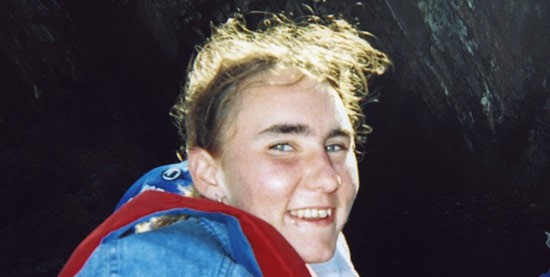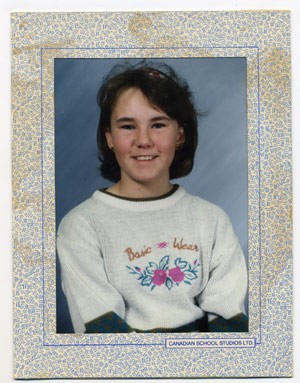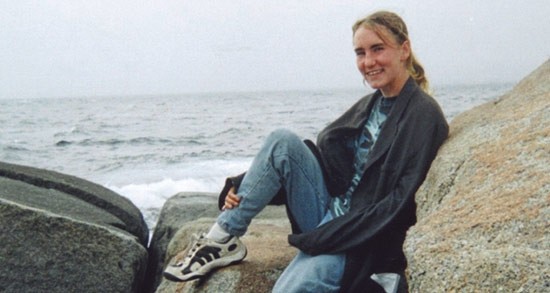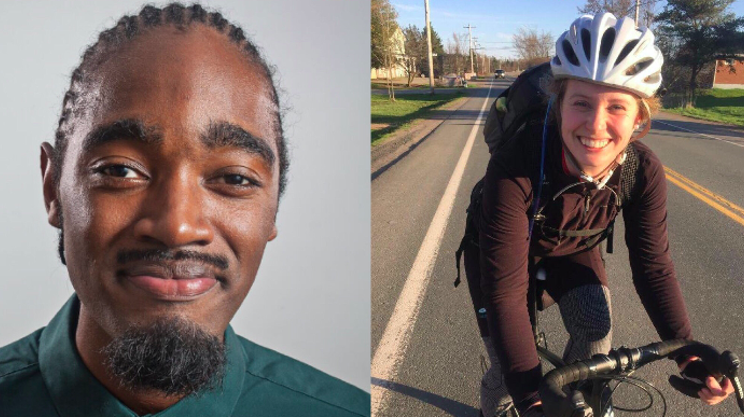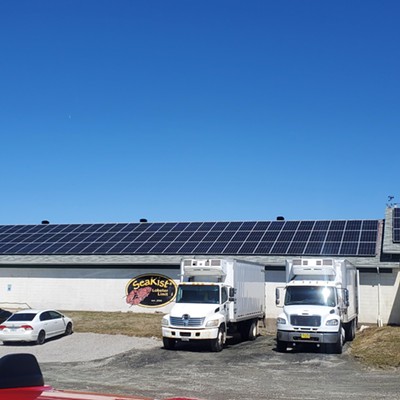Amy Lee Collins had to go to the hospital. But she didn't want to. She hated hospitals.
So she said to the two friends she'd been spending the day with at her North Park Street basement apartment, "I'm fine. I'm fine."
She had already had one seizure.
Then there was another.
Then, in time, another.
Amy had epilepsy. And when she came out of the last seizure—with drilling pains in her temples, feeling achy and thirsty—she told her friends again: "No." And they didn't push it.
Then Amy's husband Safety came home.
Safety took one look at Amy. It didn't look like she'd had a normal epileptic seizure.
"You have to go to the hospital."
Safety knew when he left that day that Amy wasn't feeling well; what she hadn't told him was that she was so ill she hadn't eaten anything for two days. She was also severely dehydrated.
The ambulance arrived. Wee-woo-wee-woo-wee-woo.
Amy was routed through Emergency and then admitted to a bed on floor 5.2 of the Queen Elizabeth II Health Sciences Centre's Infirmary building on Summer Street. The Intensive Care Unit. Room four. Out the window sat a grey-grassed November-chilled Citadel Hill. Amy and Safety's North Park Street apartment building was just right there. Like you could reach out and touch it.
Room four was private. There was a nurse there 24 hours, just outside the room's sliding glass entrance. Inside the door, there was a curtain; beyond that, there were more barriers. If visitors wanted to interact with her, to touch her hair or bring her a get-well card or just pop in to tell her the weather, they had to don gloves and gowns.
"Basically," Safety says, it looked "like where you go to die."
And for Amy Collins, it was.
There was an obituary. But you might never have taken note because even though you knew Amy to see her, you probably didn't know her name.
The other public marker of Amy's death, though, you would most definitely have seen.
By mid-December, a whitewashed wooden pallet was propped up as a makeshift memorial on the median strip between North Park Street's northbound and southbound lanes.
REST IN PEACE
1981 Amy 2006
Three of Amy's friends built it out on the back deck at the ARK youth drop-in centre on Gottingen Street. They placed it without ceremony or permission. It was the perfect place, the spot people saw Amy pretty much every day panning for change with Safety.
The memorial stayed up until January, before municipal workers removed it. Or maybe it wasn't the city. But it disappeared nevertheless.
The wooden pallet memorial bore a photo—Amy, beaming in a black t-shirt and bandanna—flanked by pine boughs and one of the North Common neighbourhood's first Christmas wreaths.
If you're one of the thousands of people who walks or drives by the intersection of North Park and Cogswell every day—Amy and Safety's intersection—you would have recognized Amy instantly. And it might have been the first time you found out her name.
Amy Collins was devoted to her notebooks, which were sometimes simple three-subject Hilroy scribblers and sometimes comparably dearer 65 lb. acid-free sketch pads. She was a journal writer from way back who penned poetry and open letters, recreated dreams and reminiscences, and felt-out her thoughts. She drew as a way of journalling, too. And she was a big fan of lists.
Sometimes she used a ballpoint pen, sometimes a liquid gel. She always wrote in capital letters and often jotted her notes on a diagonal, like she was lying down when the ideas came to her.
Some of Amy's lists were random—like she was culling appointments from her brain and copying numbers she'd scribbled on her palm and taking notes from television commercials all at the same time.
Terry + mother
Apts. Dr. Conrad
Tomorrow 2:30
(Thursday)
MacDonald Block
555-1212—INFO
TBS Sunday 8
Ms. Congeniality
What Women Want
Some were strict to-dos. Action instructions for the week to come.
MSI 468-9700
Use card 'till June 1
Get form, someone with address to certify residence
Copy of birth certificate
Meth 420-0566 Direction 180
Get medical completed
Get tax slip, file for GST for 2003
Sin #
Copy of birth certificate
There were lists of phone numbers and addresses, too.
Daddy in Madoc, Ontario
Dr. Fay
Angela
Seaton House
"Special Care"
Carly in Apsley, Ontario
(April 4, Happy Birthday Carly, coveralls, beer pockets.)
All what you might expect for the average half-organized 25-year-old.
Except this.
10 reasons not to use crack
1. It's the Number 1 drug to make you fall apart.
2. Think of the comedown: Is 5 minutes of confused pleasure (if that) worth sacrificing a 2 hour comedown? feeling suicidal, worthless, empty + in need, unhappy + just shitty.
3. You will not be able to take care of Safety, your #1 priority. If you're on crack you cannot keep him off drugs if you're doing them yourself.
4. I've been raped over 20 times because of crack.
5. I've prostituted for crack, ripped people off + put my life at risk whenever I needed just to get a hit.
6. I get arrested + harassed by cops a lot while doing crack.
7. You get ripped off all the time + even if you don't you're basically never satisfied with the high, anyway.
8. There's no such thing as "1" hit—if you do a hit of crack you will keep doing it as long as you can sustain yourself, basically until you can't get it for a good 6 hours + have time to think—if you're lucky. In other words, there's no such thing as "treats" because you will keep going. You're instantly re-addicted.
9. Even if you do succeed to just do 1 hit, you will go through another 2 weeks of extreme mental + physical withdrawal all over again + the cravings will be as intense as they get—you'll be back at square one.
10. Any time you touch crack you are risking your house, your health + your husband. Crack could kill me + start endocarditis, + Safety will have no hope if I'm off. Everything I've worked at for the last year will be shattered + I can no longer say I've been off of crack for 4 months—you'll be back at square one.
PERIOD
If you know how important your lists of appointments and errands and reminders are to you, and you can imagine how telling they are about the ins and outs of your day, then you can muster just the tiniest understanding—an inkling, really—of how important that kind of list was to Amy Collins.
Amy met Safety back in the summer of 1997. Safety was 21. And he was old.
Safety was old because at 14 he left home—a "living hell...my mom was schizophrenic...we would have ended up killing each other"—to live on the streets of Toronto, his hometown.
At the age when the friends he started grade primary with were graduating university, Safety had seven years experience getting by with no one to answer to and no one to look to for help other than himself; more than half those years—the first four—he spent literally on the street, sleeping in alleys or abandoned buildings. "I never wanted to sleep on the side of the street or to sleep in a squat," he says. "But I was never ashamed of it."
He's had the nickname Safety since he was 13, when he started hanging around with punk rockers and they noticed he would never ride in a car without wearing a seat belt. At age six, Safety had seen a head-on collision and someone flying through a car windshield. "A mess of hair and blood and brains. And my dad said, "see, that's what happens when you don't wear your seat belt.' That freaked me out for a long time," he says.
It was an early summer day. The heat of the season was unfurling itself, a promise of the unbearable southern Ontario humidity to come. And in front of Safety there was this girl. This petite little punk girl. She couldn't have been more than 100 pounds. She was washing car windows with a squeegee and a bucket full of soapy water. She was collecting change from the drivers. A dollar. Maybe two.
Her name, she said, was Amy Collins. She was 16, had just finished grade 11 a couple of weeks before and had moved to Toronto, alone, from Peterborough. But before Safety approached her and found all this out, before he even saw 16-year-old Amy, he saw something else. He stopped in his tracks and looked down, tucking his chin to his chest. The pieces of metal trimming the brim of his baseball cap—a collection of small, pliable metal tops pried off used Bic lighters ("That's my trademark. I've done that since I was 16. My jacket too.")—glinted in the sun.
He was looking down at a live crab in a bucket of clear water.
"That's mine."
"Huh?"
"That's my crab."
"Oh yeah. Is it your pet?"
And that's the story.
The one they might have told their kids and grandkids about how they met (with the requisite back story—Amy was walking by a restaurant in Chinatown and felt bad for this about-to-be-cooked crustacean and bought it. The staff were baffled, gave it to her in a bucket). Safety could have told and re-told the tale, holding up his hands like he was about to eat an invisible Big Mac to show the size of the crab. Amy could have put up a mock protest as the kids laughed and laughed and laughed.
After the crab thing, Amy and Safety became friends. Two months later they started going out. "Amy was my soulmate," Safety says.
It was a summer wedding, two years later, in Toronto's Grange Park, behind the Art Gallery of Ontario. About 50 guests. Safety walked up the aisle in a studded leather jacket with chains and a set of no-matrimonial-pun-intended handcuffs hanging from one side. Amy wore a black lace dress. Pops, a grandfather of the Toronto street-punk scene, officiated.
"In the law's eyes, I guess we weren't married," Safety says, "but in our eyes, we were married."
Their rings had black stones and tribal designs. Amy found them at the flea market, $10 for the set. Safety isn't wearing his now. It's gone.
Also missing are their wedding photos. "When we were hitchhiking here," he
says, "we lost a bunch of our stuff."
That was in 2000.
The year before, the two were in a demonstration against Ontario's Mike Harris government. "Me and Amy—well, Amy, not me—was throwing bricks at riot cops."
Amy. Not Safety. But notice how he starts the sentence in the collective? Like they're one unit. One person. He does it all the time when he talks about Amy. Later in the story of Amy and Safety, they will each have heart surgery, within nine months of one another. Safety calls the time "when we had our heart operation."
Anyway, after the protest the police were looking for Amy. They had her on tape chucking bricks.
They left Toronto and headed for Amy's hometown, Peterborough, Ontario.
Peterborough is an hour and a half on the bus from Toronto. About 140 kilometres. But it wasn't far enough. Amy was caught there and served 60 days for assaulting police. The couple stayed on almost a year.
But it was a small town and they needed out. Amy had never before been outside Ontario. Safety says, "My adoptive parents are from Newfoundland so I used to come to the east coast every summer, to a little place called Twillingate. It's in that song, "I's the bye that builds the boat.'"
Halifax made sense.
This is around the first time you met Amy.
Well, maybe you never really met Amy. But you saw her, and Safety, early on at the Willow Tree intersection; Amy and Safety were the first people to wash car windows for change at the busy intersection of Quinpool Road and Robie Street.
They introduced Halifax to the concept of the so-called squeegee kid.
Safety says, "People were weird at first. But we got a lot of support. People liked it. We were polite. We always asked. But then a lot of kids now, well..."
Safety takes off his baseball cap with the DOOM patch and runs his fingers through his dark brown, wavy hair. It's thinning only a little, even though he's now 31. Safety has a scruffy beard and unclipped finger nails that curl under at the ends. His pause continues. Safety doesn't want to dis anyone.
After the Willow Tree, Amy and Safety moved to "their" intersection—at North Park and Cogswell, where they panned for change from light-stranded cars.
They made enough money, Safety says, shrugging and focusing on digging the last few scoops of orange sherbet from a 250ml container. "We didn't need much."
Some people "will roll down the window and talk to us. They'll say, "I used to be in your shoes. I hope this helps. I know what you're going through.' You can tell by the way people act that they're OK with it. Some people," he says, flicking the plastic spoon he's now licked clean of the last traces of sherbet, "say "get the hell away from my car.'"
Amy and Safety worked the North Park and Cogswell intersection, often as a couple, up until November 28, 2006.
In her journals, Amy kept a withdrawal diary. That's where she wrote her lists of reasons not to use crack. It's there that she focused her energy when she was feeling like she needed to go out and get high.
In a society where addiction is viewed at best as an unfortunate character flaw and at worst as a morally wrong choice, the idea of a withdrawal diary can make people feel very uncomfortable. In the case of more socially acceptable diseases, like cancer, the ill can share their healing stories; the public is invited, even expected, to support the struggle for a cure. Red ribbons, pink ribbons, marathons, telethons.
No so with addiction.
So Amy's withdrawal diary might make you uneasy. It might embarrass you. It might seem like a scandal, for her to be writing down what it feels like to yearn—yearn—for a hit.
But Amy's withdrawal diary is an accomplishment. And a chronicle. Amy injected crack, had done heroin and cocaine, injected dilaudid, used morphine, smoked pot. She was an IV drug user for eight years. She was also working like crazy to stay clean. Working harder than she'd worked at anything else before.
"Hey there little withdrawal diary! Yes I'm jonesin' pretty bad—that's why I'm here! But I'm proud + I feel strong + confident—all the good stuff. I was (WAS) having a really bad craving for crack. About 3 times I had come 2 inches from walking out the door...
The next entry's writing is smaller, harder to read.
Once again I slipped up, back under satan's wing—crack. The most evil, overpowering drug + it just completely ruins a person, devours your mind to the point where every breath you take + every move you make is somehow related to your next one. I never quite realized just how sick + twisted these people + these drugs are until I got off them, cleared my head + took a realistic point of view + it's just disgusting. I just wish these thoughts came to mind when I needed them, rather than after it was already too late....
Then it's back to normal.
Well hello again dear diary. I just felt I had to write down something about this—my writing is really helping me to avoid thinking of drugs and I'm enjoying it and the last couple days I've been thinking of putting aside an hour or two every day to sit down + write a book. I have a real good feeling I could do something productive....
And, again, shrunken.
Hello again dear diary—no wait, that's withdrawal diary. Oh yeah. Well, as you probably guessed, I'm having a rough time...
And on it goes.
...I'm doing a lot better now. I shower, I eat, I've gained 40 lbs. I don't need to pan, I have a roof + I don't do needles anymore. I really was sick of the lifestyle, it was just so hard to drop it all.
"It's an intense journey for people who become addicted," Dorothy Patterson says. " never ever wanted to be there."
Dorothy was Amy's friend, one of the first people Amy and Safety met when they came to Halifax seven years ago. She runs the ARK, the youth outreach and drop-in centre located on Gottingen Street.
Dorothy remembers a cartoon Amy drew for a mutual friend. Amy was in the drawing; she had built a small fire and thrown needles into it. There was a rainbow on the other side. It's a recurring theme in Amy's art—cartoon dogs breaking syringes in two, a painted self-portrait Amy's mom has now of Amy running through a tunnel looking back over her shoulder as she flees an invisible fear. At the end of the tunnel sit two arched wooden doors, half-open. The outside beyond is sunny and blue-skied. The tunnel is grimy and black.
"She could always see the light," Dorothy says. "She knew she was going to be free. She always found brightness in the day. And she kept struggling. I mean, she did really well, and then she fell back."

There is a snapshot of pajama-clad Amy with her sister on Christmas morning in front of the tree. There is a Sears Portrait Centre shot of her as a chubby baby in a fuzzy yellow zipped-up suit; she's so new her head leans on her body and her body—just two hand-lengths long—is propped up in the crook of her mom's arm. There is four-year-old Amy in a tulle angel costume with white cardboard wings and a Christmas tree garland halo resting on top of her ears.
And there is an elementary school photo.
Grade four, let's say. She's got one of those acrylic easy-wash sweaters every grade four girl has worn since the 1970s, gold-plated button-sized earrings, a headband half-taming her not-quite curly, not-quite-straight hair.
The photographer, or maybe the photographer's assistant, gently grabbed Amy's shoulders to show her the direction her body should point. He told her to put her hands on her lap and turn only her head to look at the camera. OK, now, "Cheese!"
It's impossible to muster a real smile in that position—straight-backed, awkwardly twisting her spine. Amy tried, though, tried the same way her classmates tried ahead of her, gawky on the photographer's cushy, twirling stool, thinking: look happy. Make this photo look nice. Come on, camera, make me look pretty.
This photograph is of any little girl in any elementary school anywhere in Canada.
In August, the month before that picture, Amy stood with her mouth open, waiting to have her temperature taken. Then it was her little sister's turn. Jaclyn is two years younger. Neither girl was old enough yet to put up an argument.
Their grandmother—Granny, their dad's mother—took the glass thermometer out of the china cabinet like she did every time they came to visit. Amy held it under her tongue. When will this stupid minute be up? she thought, silently impatient. Her grandmother slipped it out, checked the reading and gave it a shake before she popped it into Jaclyn's waiting mouth.
After their informal check-up, Jackie and Amy were allowed to slip out the side door to play. They turned the tips of their tiny white fingers purple picking and slurping up the ripe raspberries that grew in the bushes separating the backyard from the hay field. In winter there were snowmen to build. In autumn they played in the fallen leaves or picked flowers.
This is the Amy that her mom knew best. The Amy in the elementary school photo with the sweater and the gold-plated earrings. Before Amy left home, before Safety, before Halifax, before room four in the ICU.
The human heart is a muscle. It is juicy, thick, heavy for its size. Like a beefsteak.
Despite our fondness for the poetics of breaking hearts, hearts pained by words, hearts injured by the deeds of loved ones, hearts are not delicate possessions. What they are is vital.
The heart's tricuspid and mitral valves are like miniature parachutes with cords on the inside. A jellyfish's tentacles. The pulmonary and aortic valves are like little scoops that come together in the shape of a Mercedes logo. A translucent membrane.
The endocardium is the lining—a microscopic layer of cells on the inside of the heart and the valves. If you could look at it closely, you would see its fineness, wraith-like.
When you have endocarditis, that's where the infection takes hold.
Before the ambulance took Amy to the hospital after her seizures that day, before she was admitted to room four, before the painkillers and sedatives began to affect her consciousness, Amy probably already knew it was endocarditis. It was the third time her heart had become infected.
Plus, Amy had done her homework.
Endocarditis
causes—bacteria, fungi, virus, microorganisms.
symptoms—numbness, pain, fatigue, weakness, fever, chills, night sweats, weight loss, muscle aches + pains, heart murmur, shortness of breath, swelling: feet, legs, abdomen, blood in the urine or coughed up, excessive sweat, Janeway lesions: red skin spots on palms + soles of feet, paleness, nail abnormalities: splinter hemorrhages, under nails, joint pain, abnormal urine colour, red painful nodes (Osler's nodes) in the pads of fingers + toes.
Highest risk factors—heart disease, IV drug use, chronic abscesses or infection.
—heart failure "not uncommon," valve replacement "common."
—complications: congestive heart failure; blood clots or emboli: travel to brain, kidneys, lungs, abdomen, causing severe damage; Arrhythmias: rapid or irregular heart beat; Glomerulonephritis: ? <*; severe heart valve damage, stroke, brain abscess, brain/nervous system changes, jaundice.
Safety left the Infirmary building elevator and walked over to pick up the tan-coloured phone on the wall outside the ICU. He explained who he was and got
buzzed in through the large green metal doors with frosted glass at the top.
He walked straight ahead, down to the very end of the corridor, to reach room four.
Safety put on gloves and a yellow cotton gown. It was long, coming down to his knees, and the sleeves were long too. They gathered at the wrist just a little too tightly—like a new sweatshirt on Christmas morning. The nurse tied the gown in the back for him. He slid open the glass door.
There was Amy, pretty much unconscious.
But not completely. She followed instructions from the nurses, and if they spoke loudly enough she opened her eyes. How much she actually saw was unclear, same went for how much pain she was in.
"Amy. It's Safety."
Amy squeezed Safety's hand. She opened her eyes a slit.
"You don't have to strain yourself. I just want you to know that I'm here."
Amy squeezed Safety's hand again.
That was pretty much it.
Halifax's weather on this day—day two of Amy's hospital stay—became unseasonably warm. It was November 30, 2006. Twelve degrees.
The emotional temperature of Amy's room changed too.
Amy's mom, Kim; her step-dad, Pete; and her sister, Jaclyn, arrived. Amy's step-sister, Katie, nine years Amy's junior and the same age Amy was when she met Safety, was in school and couldn't make it.
There's no delicate way to characterize the reasoning behind the shift that took place on day two of Amy's five-day stay in the ICU. The dynamics of the relationship demand a more sophisticated explanation, but here's the bottom line: Amy's mom and Safety aren't the best of friends.
There is no out-and-out fight here. Safety is friends with Amy's sister Jaclyn, who had visited Amy and Safety in Halifax and he says he gets along "fine" with Amy's mom. "If I ever go back to Ontario I will go see them," he says. But, "she kind of held a grudge. Like, I brought Amy all the way out here to Nova Scotia."
Amy's family became a bedside presence; Safety got the discreet nix.
This was the first time Amy's mom had been to Halifax to visit her. It was the first time she'd seen her daughter in the flesh in many years. After divorcing herself from her mother's life in her teens, Amy had begun to reconcile with her mom about a year-and-a-half before, starting with phone conversations. This was at the suggestion of Safety, whose own mother died in 2002. "There might be some things you need to say," he had told her.
So the reconciliation process continued, bedside, between Amy and her mom. December 1, 2006—day three of Amy's hospital stay—it was even warmer outside. Thirteen degrees.
When Amy was eight years old drawing was her thing.
She picked up some thick markers one day and drew a collection of teddy bears, labelling each bear in her juvenile printing—Honey Bear, B'rrr' Bear, Playful Bear, Baby Bear, Furry Bear. She added an exclamation point after each bear's name. It's an eight-year-old's subject matter rendered in what could be the hand of a skilled adult. Amy gave the drawing to a friend of her mom's. The friend was so struck by the drawings she could never give them up. They were mounted with a border of raised fabric letters—AMY'S BEARS. Amy's mom faxed a copy to Dorothy Patterson for her daughter's Halifax memorial service, which took place at the Brunswick Street United Church.
Through her uneasy teen years, into adulthood, Amy never gave up drawing.
"She was an awesome artist. Perfect," Safety says. "She used to draw cartoons, like a cat poking its head out of a garbage can with fish bones in its mouth. She could draw the Family Guy in, like, 10 minutes."
Amy's best friend Terry says that if Amy were to define herself, she would probably say one word: "artist." Dorothy tells this story:
"Amy came in one day from panning," Dorothy says. "Someone had spit on her as they were driving by; she was just so, so upset. She spent a few hours typing a letter about her life and what it was like to live on the street and be abused. And she gave it out to cars the next day. Because she wanted them to know that she wasn't a piece of shit. She was a human being who was just trying to make it by. She had the same dreams as the person who spit in her face. She put her phone number on it and she signed it: Amy, the artist."
Drawing was Amy's way of processing the day, of lifting stress, of telling her story. There are as many drawings in the pages of her journals as there are entries made up of words.
But one of Amy's drawings sticks out.
It's a self-portrait—young Amy, in a bed. A teddy bear poking out of a corner. And a still, menacing figure. Tall and older.
This isn't a secret. Not from Safety, not from Dorothy, nor Terry. Not from anyone. This drawing tells where the rift between Amy and her mom took root. It tells the story behind Amy's leaving home. If you understand that addiction is a disease with roots in early development and a disorder often worsened by the trauma of childhood episodes, you can think of this scene as a piece of the puzzle of Amy's drug addiction.
"For her, it was live on the streets or get molested," Safety says. She had no choice.
The Ford Motor Company says different.
There is a prime-time television commercial for Ford trucks voiced by Canadian actor Kiefer Sutherland. It's got the usual bumpy shots of vehicles crashing over water and rocky terrain. Sutherland's voice-over drills the viewers. It says, at one point: "There is no can't, only won't."
Sutherland might as well be talking about attitudes toward the poor, the homeless and the under-housed.
"Some people think we're just lazy and we could just pick up one day and get a job and everything would be better," Safety says.
"A lot of times," says Dorothy, "we get questions when we do presentations, like: Well, they just don't like the rules, do they?"
Dorothy has a few questions of her own.
"Why do 14- and 15-year-olds fall through the cracks? Why are 12- to 21-year-olds the fastest growing segment of homeless people?" And, "Would you sleep outdoors for months in minus-10 weather just because you didn't like the rules?"
Amy had questions too. She asked some in her journal, in a draft of a speech she gave one Christmastime at a special service at Trinity Anglican Church on Brunswick and Cogswell Streets commemorating the struggles of homelessness and those who've died on the street.
Why are so many of us treated as unjust criminals for simply trying to survive?
People that tell us so rudely to get a job are the ones who will not hire us—nobody hires you when your resume says no fixed address.
Safety wonders about this particular conundrum: "You need social assistance to get a house, but you need a house to get social assistance."
"Yeah, it's a crazy little cycle, the set up we have in Nova Scotia," says Dorothy. "Basically, you can't be homeless and be on assistance." You need to have some address.
And actually, before that, you need ID. If you don't have ID—and people who have been on the streets since their early teens often do not—you also cannot apply for assistance; you can't get a job; you can't open a bank account; you can't even get a library card.
Safety didn't have ID when he came to Halifax. Neither did Amy. Dorothy helped them get it. And she helped them navigate their way into stable housing.
Amy and Safety's first apartment was off the St. Margaret's Bay Road. Douglas Drive. It was a basement apartment with a cement floor which would flood during heavy rains. There were small pieces of carpet on parts of the floor, a toxic orange-coloured fold-out couch, a drunken superintendent.
Social assistance in Nova Scotia gives recipients 19-and-older $235 per month to pay for an apartment, plus a $200 personal allowance—for food, utilities and clothing. Amy and Safety still travelled into the downtown core to pan most days, even though they were on welfare.
"I have had change and bottles thrown at me," Safety says.
Amy had been jumped a few times on the streets. She was only 107 pounds. "On the drugs," Safety says, "she was down to 93 pounds."
Amy writes in a letter to her grandmother that she had friends who were "lost to the streets"—"freezing to death, suicide, drugs, murder."
Still, she panned and squeegied. It was the only job she'd ever had.
May 6—I puked downtown around 6:00, then at 10:00. All I'd eaten was salad/Ensure/mangoes/ice cream, banana.
May 7—7:15 laying at home, Ensure, carrots, peanut/jam toast.
May 9—10:30 talking to J, ate nothing, 11:00 argued with Safety, 11:30 arguing with Safety.
May 10—? I found out about surgery, I did get sick, time?, approximately between 2-6.
May 11—Had 2 seizures 5 + 11:30, worse recovery. I remember it took 3 hours to sit up, shooting pains in forehead + temples, extremely stiff, dehydrated—it felt like there was a chunk stuck in my throat so I tried drinking water + puked 30 minutes—1 h. later. Took Tegretol (+ other meds) when I woke up (11:50), Tylenol (12:30?), Advil 1:15, Methadone and Gravol (12:30-1:30?) Puked at 2:30 + dry heaved for 20 min.
Amy's health was not good.
She had epilepsy, mild spina bifida, wry neck—a condition which would cause her to wake and find her neck wrenched, immovable, to one side. Like her ear was glued to her shoulder.
But she was working to take better care of herself—committed to the withdrawal diary, eating the best she could, keeping her doctor's appointments. When she last went into the hospital, Amy had just celebrated two years of having been on a methadone maintenance program to help her wean off drugs.
The biggest health issue in Amy's life, ultimately, was one that didn't trouble her as imminently as all the others. Endocarditis.
Amy became infected with endocarditis through injection drug use. It's a crude description—one that might make you wince if you're shy of needles—but Amy basically pushed bacteria through her skin with a needle tip. All it takes is once. The bacteria went into Amy's blood stream. It travelled to her heart. It took hold in the endocardium of her mitral valve. It grew.
Safety thinks it was from injecting the synthetic painkiller Dilaudid.
Three years ago, on a trip to Toronto, Amy and Safety were sleeping in a little self-fashioned shelter in an alleyway off Bloor Street. Amy was sick. Getting sicker. She left one morning and told Safety she was going to the clinic to get checked out. She didn't come back.
"I thought she was dead," Safety says. "I would go to sleep every night and cry. I would kiss her picture and cry, thinking someone must have abducted her and raped her and killed her."
Two weeks passed.
Amy was unconscious in hospital, on a round of intravenous antibiotics to help clear up the heart infection. Safety was nearly dead when Amy got out and found him in the alleyway off Bloor. He had an infected endocardium, too—the tricuspid valve. Safety had emergency heart surgery.
The scar that runs along Safety's chest is about seven inches long. Ruddy and uneven. It's flanked by two small round puncture wounds where surgeons inserted tubes to drain the liquid that was leaking into Safety's lungs during the operation.
Amy had the same scar, minus the puncture wounds, from the valve replacement surgery she had nine months after Safety, in Halifax, after she was strong enough to undergo the procedure.
Amy's scar was reddish and ran six inches dead-centre down her chest from the notch in her collarbone. Amy used to use the tips of her fingers to slip along the scar, like a Braille reader. Underneath it, she could feel the ridges on her sternum that had formed as the bones grew back together. It freaked her out, how she could feel where the surgeons sawed the bones and pried her chest open.
Amy hated her scar. She always wanted to get a tattoo of snakes crawling up between her breasts to cover it.
With Amy's second endocarditis infection—in the spring of 2006—she again was put on antibiotics, first IV and then tablets because she didn't want to be stuck in the hospital any longer. The infection cleared up. Or it seemed to. But as the summer came to its close, Amy was getting sick again.
After she died, her best friend Terry had Amy's wallet. He found a blood requisition form inside from the autumn. Amy couldn't stand having blood taken. She had collapsed so many veins that when she was still doing drugs she had moved from injecting into the traditional inner elbow to her ankles, her knuckles and the palms of her hands. Eventually, she had to do it by looking in a mirror and shooting up into her voice box.
The third and last time Amy's heart became infected, well, it just happened really fast.
Day four in Amy's room at the ICU was monotonous. Nothing was happening.
And that's how it goes when people are dying. There's nothing to do but wait. Loved ones sit on the bedside chairs, heads cocked, tired, willing something, anything—movement, talking, dying, breathing—from the person in the bed.
Death is a transformation. Like a caterpillar becomes a butterfly. Everything happens on the inside. When someone is dying slowly—succumbing—there's not much to see. And less to do. Bedside death-watchers tell each other to get some rest or go get a cup of something hot. They stare at the floor. They gaze out of the window. They raise their heads when nurses or doctors enter the silent sanctuary.
On day four, room four's occupants—Amy's best friend Terry, her mom Kim, step-dad Pete, sister Jaclyn, and just-arrived biological dad Lee (who split with Kim when Amy was a pre-schooler)—moved in waves. Two came up to the bedside by Amy's head to sit in the simple chairs. When those two were spent they moved back and two more moved up.
Amy's visitors left every once in a while to get coffee, or a break for air. Or they were politely shooed out by nurses who needed to change bedding. Amy's blood was not clotting and she had catheters in her legs. The sheets got wet with blood. She had also been diagnosed with MRSA—Methicillin Resistant Staphylococcus Aureus, an antibiotic-resistant bacterium. The already small inventory of allowed visitors was trimmed and masks were added to the list of precautions visitors had to take before entering the room. The masks pinched tight at the bridge of the nose and trapped the hot, moist exhalations of the mouth.
Amy's loved ones looked outside at the people walking along the base of Citadel Hill. The weather was still on its run of out-of-the-ordinary warmth. Another day, another degree warmer. December 2, 2006. Fourteen degrees.
They knew Amy was about to die. Did Amy know she was about to die?
Her body was septic. Amy was covered with a logo-stamped hospital sheet but the parts you could see—her hands and her arms and her feet—were black. She could only be touched very gently.
This is agonizing. This is hideous, Amy's best friend Terry thought. She is dying. Get out of here. But his heart just kept drawing him up to her bedside.
Terry, who was there every day in the early morning and, after a break, until the middle of the night, came that day to room four to find out the decision had been made to withdraw Amy's life support.
It was day five. December 3, 2006, and freezing again. The temperature had dropped 14 degrees overnight. This was the last day.
Amy's mom said it was time to bring in Safety.
He spent an hour with her. This time, she couldn't squeeze his hand or open her eyes.
"You're going to a better place.
"You won't be in pain.
"You won't suffer there."
Two hours later, Amy died.
COLLINS, Amy Lee—Beloved daughter of Kimberly Hallihan and Lee Collins. Passed away December 3, 2006, in her 25th year, peacefully at Queen Elizabeth II Hospital in Halifax, Nova Scotia. Dear sister to Jaclyn and Katie and granddaughter of Mary Lou Hogan and the late Patrick Hogan. Amy will be deeply missed by her good friend Terry Godwin of Nova Scotia, as well as her many aunts and uncles. Cremation has taken place and a celebration honoring Amy's life was held in Halifax, Nova Scotia. A private family gathering will take place in Peterborough. Because of Amy's love of animals, donations to the local Humane Society would be appreciated by the family.
Amy's obituary ran in the Halifax Herald and her hometown's Peterborough Examiner. No mention of Safety.
There was a memorial gathering at the Brunswick Street United Church four days after Amy died, so her Halifax friends could mourn. Amy's mom, step-dad, dad and sister were unable to stay, but her mom sent a picture and a note to share with the crowd.
The picture she sent is the one of pre-school-age Amy in the white tulle angel costume with the cardboard wings. "I selected this photo," Kim wrote, "to honour Amy's memory today, for she will always be in my heart and forever my angel."
At the end: "Our family would love to know more about her experiences in Halifax."
Safety has pictures of his own. Pictures of his Amy.
He pulls his favourite out of a grey metal case held together with duct tape. It's Amy sitting on a foam mattress on a parquet floor. Motorhead t-shirt. Black sweatshirt. She looks like she's just woken up. The sun is streaming in a window, washing out the colour of her face and flashing on her lip ring. "She had blue eyes," he remembers. "Lovely blue eyes."
Safety has other photos, too. And he has Amy's jean jacket. That's about it. Amy's mom had her remains cremated and she took the ashes on the plane back to Ontario. "Her mum is just going to keep them," Safety says.
"We used to go sit up on Citadel Hill sometimes," Safety says. "Like at nighttime, we'd go lie there and look at the sky. That's probably where I'll go to remember her. Just look at the sky."
Life is like an improvised dance between the multiple personalities and people that exist within each one of us. So how do you figure out which person is the real person? The Amy her best friend Terry describes—chirpy and charming—was different from the Amy drivers saw every day at the North Park intersection—an Amy who was sad, shuffling and despondent—and different again from the Amy Dorothy Patterson misses today—an articulate, communicative caregiver. Was the real Amy the vegetarian who was into animal rights? The affordable-housing advocate? The Amy who never missed a Mike Harris demonstration back in the '90s? The one who always voted NDP? The street kid? The wife? Was Amy the pre-schooler in the tulle dress and cardboard angel wings? The awkward grade four kid with the white acrylic sweater trying to smile and look pretty? Was the real Amy the one who wrote letters to her husband like this: ...stopping by Red Cross to see if I can help with Hurricane relief. Back soon, Luv Amy XXOO And lists to herself, just like you do, too. Have a bath How many ways can you write an obituary? How many ways can you chase Amy Lee Collins? Click here for an archive of images from Amy’s life and journals. Lezlie Lowe is a freelance writer in Halifax. She recently won an Atlantic Journalism Award for feature writing for her “Living with HIV” series in The Coast.
See Dr. Frasier
Get blood done, yo
Go to ARK
Watch Days of Our Lives
3:00 aft—gynecology
4:00 ARK—dinner
Advantage for Trouble
Type letter for Terry
$10 for Advantage
Get blood requisition from N'End Clinic

